Do you have a new second DNA match that is a mystery to you? In this post, I'll teach you some strategies that you can use to help you determine how your second cousin DNA match is related to you.
These tips will help, even if your DNA match doesn't have a posted family tree on their profile.
In order to show you some of the techniques that I use to learn more about my DNA matches, I'll walk you through my exploration of my mother's newest second cousin match, who we will refer to as Ella. I don't recognize Ella's surname, and Ella hasn't logged back in to her account to check her results, even though it has been more than a week.
Let's get started learning about our second cousin matches!
The second cousin designation for the DNA match is just an estimated relationship
Ancestry DNA estimates that Ella and my mother are second cousins. The very first thing that we need to know is that this is only an estimate, and there is a range of possible relationships that my mom and Ella might share.
Ancestry uses details about the amount of DNA that we share with our genetic relatives in order to estimate how we might be related. They use this information to place our DNA matches into different categories.
The provided estimated relationship is only an estimate, however, and so we usually have to do a bit of our own research in order to figure out the exact relationship.
This is a very important point to understand. If I was sure that Ella and my mom are second cousins, then that would mean that they would absolutely share great-grandparents, and it should make it easy to figure out which set of great-grandparents they share.
However, since I know that it is only an estimate, I must keep an open mind while exploring the options.
Start with the amount of shared DNA
To determine how your second cousin DNA match is related, you should start with the total number of centimorgans that you share. This is one of the most useful details when it comes to discovering how our DNA matches are related.
Wouldn't it be nice if we could just know for sure how someone is related based on the shared DNA?
This whole DNA match thing isn't that straight-forward, unfortunately. So how do we know which relationship distances are possible for my mom and Ella?
We have to look at the amount of their shared DNA to get an idea:
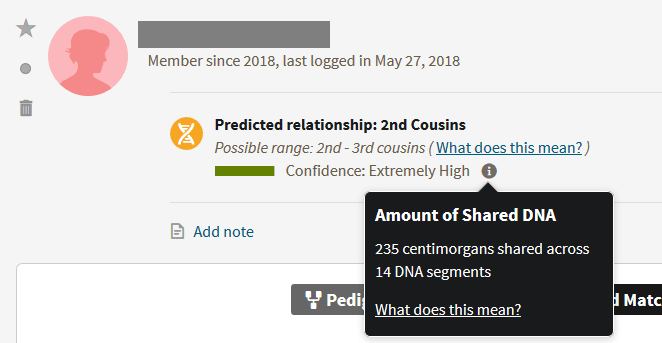
When I first look at a new DNA match, I try to just look at the facts available, and see what they tell me - instead of trying to make the facts go along with a story or assumptions that I already have. Ella and my mom share 235 centimorgans of DNA across 14 different DNA segments.
This amount of DNA falls within a range of shared DNA that overlaps with several different relationship possibilities. Some of the possibly relationships that Ella could have with my mother are listed below.
The list below is not a comprehensive list, but it gives you the idea that we should have a really open mind when trying to figure out who our common ancestor is, and the exact nature of our relationship:
- First cousin once-removed
- First cousin twice-removed
- First cousin three-times removed
- Second cousins
- Second cousins once-removed
- Half-great niece
- Great-great niece
- Half-first cousins
- Half-first cousins once-removed
- Half-great aunt
- Half-great-great aunt
- Great-aunt
This is quite an extensive list of relationship possibilities. It means that the most recent common ancestor shared between a person and their second cousin DNA match can be as close as a grandparent for one of them, which would the case in first cousins once-removed.
However, their common ancestor could also be as distant as a great-great-great grandparent, such as would be the case for first cousins three-times removed. In this situation, one person would be the grandchild of the other person's great-great-great grandparents.
Of course, in this last example, we would usually expect a very large age difference between the DNA matches. This would provide an important clue, and we will go into further detail about using age to eliminate some possibilities further on in this article.
As you can see, it is very important to keep an open mind about where someone might fit into your family tree.
Next, check your shared matches, or matches in common
Obviously, I need to eliminate some of these relationship possibilities! This is way too many, and it's super confusing to think about all of the different options.
A really easy way to do this is to see my mom shares - and doesn't share - in common with Ella. All of the DNA testing sites allow you to access this type of information. On Ancestry, it is called "Shared Matches":
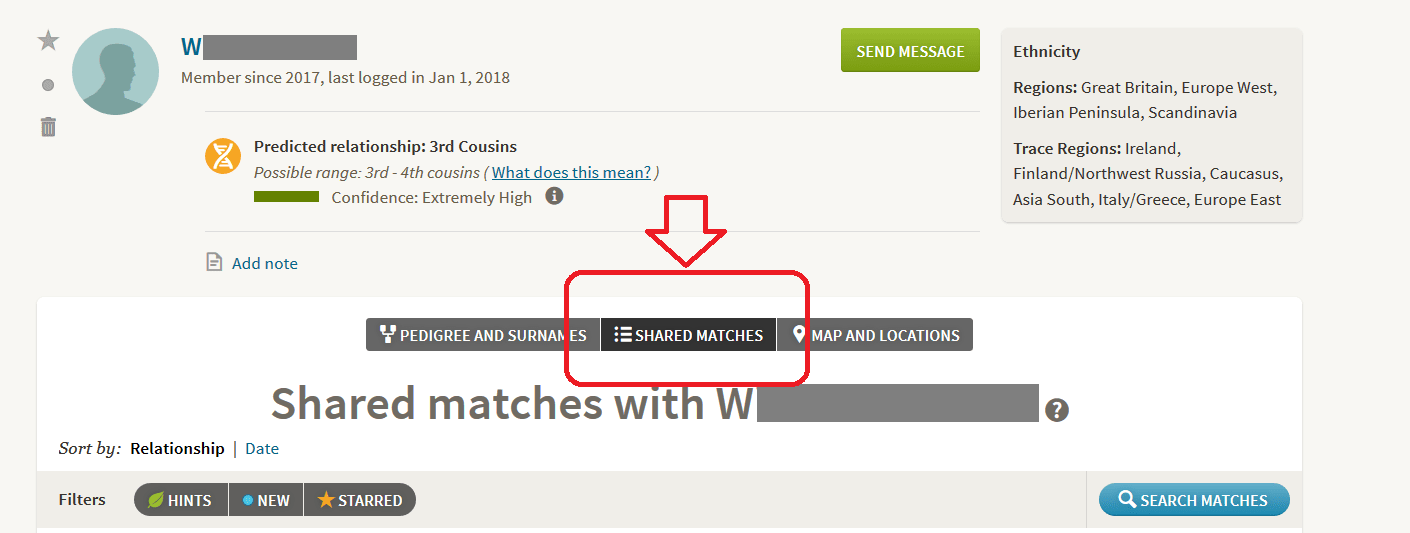
When I look at my mom's shared matches with Ella, I notice one important thing: my mom's half-siblings don't match Ella. This means that Ella is a match on my mom's dad's side of the family - amazing!
I have eliminated 50% of my mom's ancestors as potential places to look for her connection to Ella.
A few other details I realized while looking through her shared matches with Ella:
- There are no shared matches in common with my mom that match my mother's paternal grandmother's MacDonald line. Absolutely none at all, even at a 4th cousin level. It's totally possible for third and fourth cousins to share no DNA, but it seems unlikely that this match would share absolutely no DNA with more than a dozen 3rd and 4th cousins.
- I also notice that Ella shares one 3rd cousin and one 4th cousin from my mother's Slovak line in common with my mom
After checking this information, I feel confident making a few general statements about Ella's relationship with my mother:
- She is not related to my mom's paternal grandmother, which eliminates all relationship possibilities that include my mom's grandmother as a common ancestor
- She is related to my mom's paternal grandfather, but I still can't determine if he is the most recent common ancestor, or if the common ancestor is a generation or two further back
Find out how much DNA your other relatives share with your second cousin DNA match
Not everyone will be able to do this step, but if you do have access to another DNA account that matches your second cousin match, definitely check to see how much that person shares with your mystery match. In my case, I have access to my mother's two full sibling's DNA results.
My next step will be to check to see how much DNA they both share with Ella to see if it helps me eliminate some relationship possibilities.
(Note: If you haven't had any of your other relatives do a DNA test, I definitely recommend asking them to do a test. This situation is exactly the type that would benefit from more information - you can read my posts about why it's great to test other relatives and whether or not siblings have identical DNA for more information.)
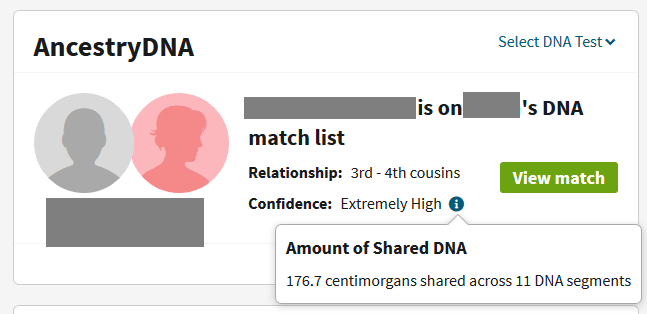
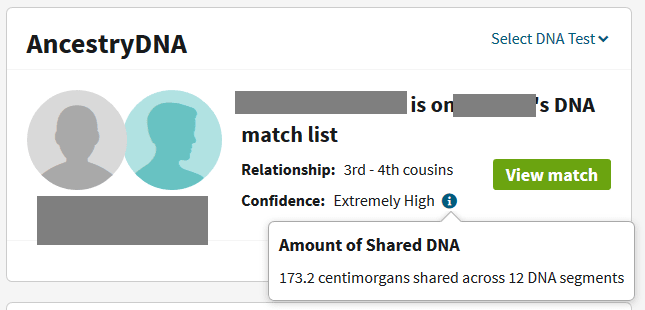
As you can see from the images above, my aunt and uncle share less DNA with this match than my mother does. Based on what I already knew, and on this new information, I now know that some of the more close relationships can be eliminated.
Again, I'll check the chart available here, looking for relationships that fall within the 173-235 cM range.
There is still a pretty long list of potential relationships, so I need to do some more digging. All I know so far is that Ella and my mother's common ancestor is on my mother's paternal grandfather's side of the family, and that the MRCA that they share could be as far back as my mother's great-great grandparents on her grandfather's side of the family, or as recent as my mother's grandfather.
Fortunately, this means that there are only two sets of great-great grandparents that I need to examine on this line of the family. Shouldn't be too hard, right?
Unfortunately, both sets of these great-great grandparents on my grandfather's paternal line were born in Slovakia and never came to the United States - as far as I can tell. I know about some of their kids, but not all of them.
This might take a little work, and that leads me to my next idea:
Make sure you are building your tree wide
Most people focus on adding only ancestors and their children to their trees. This is great, but this also means that you are missing literally tons of people from your tree.
What about those other children of your ancestors (the ones you are not descended from, but are related to)? Who did they marry? What were their children's names and who did their children marry? All of these people and their descendants are your relatives, too, and they need a spot in your tree.
The added benefit of doing this while you are building your tree is that it does make it easier to spot how a new DNA match is related. I wrote a whole post about building a tree wide, if you want to know more.
I try to do this in my tree, but I will confess that I don't have everyone added to my tree. So, to work on Ella's connection to my mom, I'm going to go back through my tree and see if I have everyone added (I'm sure I don't).
I will start with my my mom's great-grandparents and make sure I know who all of their kids married, and who their grandchildren married. Maybe I'll spot Ella's surname among these new folks?
... Okay, I'm back. It took me a few days, but I started with my mother's great-grandparents. I made sure I had spouses for all of their kids, and went through their lines individually adding kids, and then spouses for the kids, and their kids - when possible.
And I found absolutely no trace of Ella's surname.
See if Aunt Google knows anything about your DNA match
I am assuming that you already covered the absolute basics with your second cousin match, which means you checked their profile on your DNA testing site to see if they listed anything like where they live, or how old they are.
Any fact, no matter how tiny or insignificant it might seem, can be an important clue in figuring out how your second cousin DNA match is related to you. In my case, I had already checked Ella's profile and there was less than nothing.
Unfortunately, my Ella shares a name with two very famous people, so Aunt Google couldn't tell me much of anything.
Usually, I have good luck with Google searches. Keywords are your friend. For example, try doing a search like this: DNA match first and last name + obituary + surname in your family. Do the search several times with different family surnames.
For example, if my match's name is Micheal Jackson, and I think he might be related on my Diesel line, I'll type this into Google:
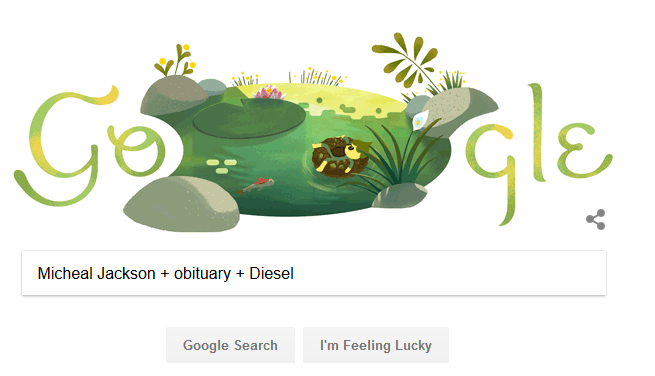
If you know anything more specific about your DNA match, try adding it in as a keyword. For example, if you know that your DNA match likes knitting and lives in Wyoming, then do a search for DNA match name + knitting + Wyoming.
Maybe they started a local knitting guild in their county - you never know!
Once you learn a little bit more about your match (age, spouse, parents, grandparents, etc) you might spot something that you recognize, like a relative's name or geographic location that is familiar to you.
Important: I'm not recommending that you stalk your match, and definitely don't post private information about living people in your public family tree. The information that you find using this method should only be used to try to determine how your match is related to you, and it should not be shared or used in any other way.
Have you considered contacting your second cousin DNA match?
The last thing on my list of things to try with my new match, Ella, is to send her a message. I just sent her a very short and sweet note that went something like this:
Hello!
I noticed you are a DNA match to my mom, and I would love to hear back from you if you'd like to see if we can figure out how we are connected.
Sincerely,
Deana Match
So, for now, I wait. I hope to hear back from Ella and that we are able to figure out how we are connected. I think I might be in for a surprise!
Conclusion
Even though I wasn't successful in finding out how Ella is related to me, I really enjoyed walking you through the steps that I took and the thought process that I use. It usually works - I promise!
If you have any questions or comments about something that you read here, I would love to hear from you in the discussion below.
Thanks for stopping by today! Hopefully I'll have news about Ella soon 🙂

Natalie
Wednesday 8th of June 2022
Can you tell me what it means if my brothers child and another brothers child came back 2nd cousins instead 1st cousins. Please explain.